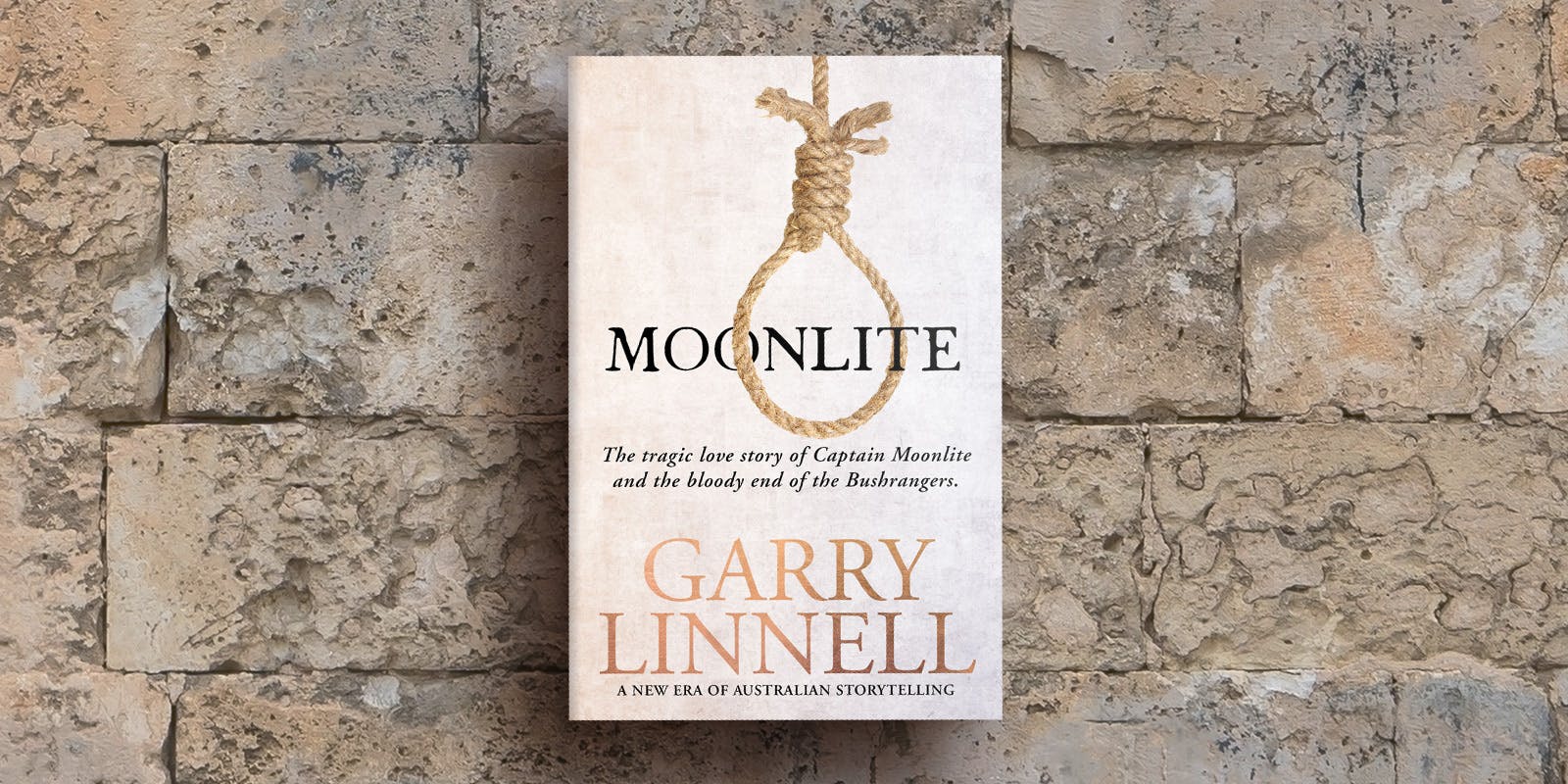Garry Linnell reveals how a childhood fascination led to his exploration of the life, and love, of an oft-forgotten bushranger.
A gay bushranger who robs banks, preaches from a church pulpit and recites poetry.
An executioner with a noseless face who hunts sharks, dotes on his children and grows flowers.
A young nation so desperate for legends it turns thugs, thieves and murderers into heroes.
What’s not to love about the true story of Captain Moonlite? And why have so few of us heard about him?
For many Australians, our colonial past is a little like that obnoxious uncle who always turns up on Christmas Day wearing a loud shirt, gets drunk quickly and then falls asleep in the corner, snoring loudly with a lampshade over his head.
Some of us are embarrassed and just want to look away. Others tend to be horrified and disturbed by the vulgarity and lack of sophistication. And the rest? They prefer to pretend it never happened.
The 19th century was often crude, uncultured and brutal. It was a time when Indigenous Australians were treated, at best, with disregard and contempt and, at worst, with a genocidal determination to remove them from their lands and traditions. It was a period when powerful men forged empires and created fortunes on the sweat of convicts and slaves. Compose a soundtrack for the era and it would be filled with the clanking of chains, the cries of the oppressed and the echo of gunshots.
So perhaps it was inevitable that white Australia – so starved of heroic figures – seized on the bushrangers as its first folk heroes. Here were men who, despite their frequent boorishness and cruelty, were prepared to defy authority and live outside the strict rules of colonial society.
But by 1880 they had fewer places in which to hide. Their world was rapidly shrinking. The bush telegraph had been replaced by an electric version. The horse could not compete with the strength, speed and endurance of the steam train. And the novelty of the bushranger had worn as cities grew and new industries sprang up.
In November that year they hanged one of the last – and certainly the most famous – of all the bushrangers. By then Ned Kelly’s exploits were already shrouded in myth and legend. He was the last of his kind and his execution would symbolise the passing of an era.
But ten months earlier another outlaw whose crimes had also captivated and shocked the nation had gone to the gallows. His name was Andrew George Scott, but everyone knew him as Captain Moonlite. In many ways he was a far more complex and intriguing character than Kelly – or any of the hundreds of others who roamed Australia’s unforgiving landscape.
As a kid I pored over bushranger books. I knew Captain Moonlite had staged one of the most audacious bank robberies in our history. I knew he had laid siege to a station outside Gundagai when he and his gang had taken 40 hostages, and that he had been executed when a police officer was shot dead during a climactic shootout.
But it wasn’t until the emergence of a batch of letters written by Scott in his death cell at Darlinghurst Gaol that a more complicated and enigmatic character began to emerge.
Unlike so many bushrangers whose defiance of authority was in direct proportion to the oppressed Irishness in their blood, Scott had a privileged childhood in a small Irish town, was educated in the Classics and served as a cadet with the British navy.
When his family’s fortunes declined, he emigrated from Ireland with them to New Zealand in the early 1860s, and not long after was seriously injured while fighting the Maori.
He moved to Australia in 1868, became a Lay Preacher noted for his fiery sermons, hung out a shingle as a Civil Engineer and gave lectures on how to construct enormous, drought-defying dams… and then robbed a bank in the Victorian mining town of Mt Egerton.
He then plied the seas of the Pacific, was jailed in Sydney for forgery, spent time in an asylum, then served seven years in Melbourne’s Pentridge Prison for the Mt Egerton robbery. And it was there, within those bleak bluestone walls of the nation’s most notorious jail, that he met a young petty thief called James Nesbitt.
So began one of the most unlikely – and absorbing – love stories in Australian history.
Inseparable in life, Scott and Nesbitt yearned to be reunited in death. When Nesbitt was killed during the siege at Wantabadgery Station in 1879, the proud and sometimes narcissistic Scott penned dozens of letters – later seized by jail authorities – declaring his love for his beloved companion and pleading to be buried in the same grave.
So when I set out to tell the story of Captain Moonlite and – given the prudishness of the Victorian era – his love for Nesbitt, I thought I already had a decent tale to tell.
I could draw on Scott’s letters and the thousands of newspaper reports of the era to not only write about his extraordinary life, but also the dying days of the bushrangers.
What I hadn’t expected was the appearance of several other characters just as colourful and flamboyant as Scott himself.
The most outstanding was the state executioner for the colony of New South Wales: Robert Rice Howard. He was a former cab driver who fell on hard times when a horse kicked him in the face, disfiguring him so badly he was left with a hole in his face where his nose once sat. Naturally he was dubbed ‘Nosey Bob’ and took on the role of hangman when his unsightly appearance turned off prospective customers.
Nosey Bob was one of those brilliantly eccentric characters only the 19th century could produce. He raised pigs in his backyard, had a horse that fetched beer for him from the pub, took extraordinary delight in growing flowers and cabbages in his backyard and was famous for hauling sharks out of the water at Bondi Beach.
Bob and Moonlite never knew each other during their eventful lives. They never spoke and, at most, probably exchanged a glance or two. But I quickly decided that I would write the book so it would culminate in their first and final meeting. It was a mild summer’s morning. It was the 20th of January, 1880. And it was Nosey Bob’s job to place a noose around Andrew George Scott’s neck.
The execution of Captain Moonlite was a massive story around the country and the rest of the world. His exploits dominated the newspapers and discussions in the streets. He was also reviled by the politicians of the time, who were embarrassed that a criminal could still become a cult figure in a nation that was maturing and heading toward federation.
Yet his notoriety didn’t last long. When Ned Kelly was executed later the same year, the legend of Andrew George Scott faded as quickly as Kelly’s enormous shadow lengthened.
It’s now time for Moonlite to shine once more.













